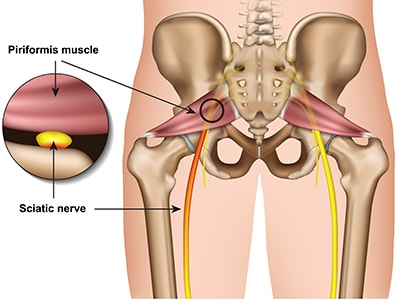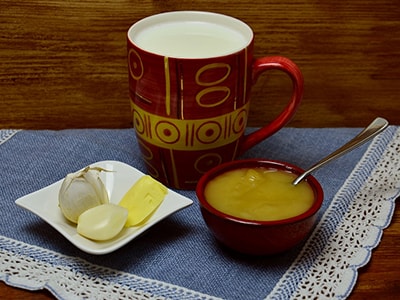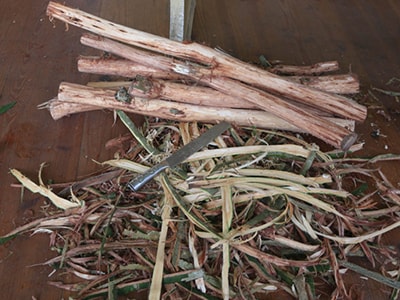
Ease Sciatic Nerve Pain with These Plants
Sometimes, you may experience pain, numbness or a tingling sensation because of injury or pressure. Compression in the sciatic nerves may cause pain in the lower back that travels down the legs and back of the knees. Any pain that originates from these areas is called sciatica or sciatic nerve pain. If you experience any of the symptoms below, it may be due to sciatica.
Causes of Sciatica
Sciatic nerves are the nerves branching from the pelvis to the lower back, hips, buttocks and lower legs. These nerves help in motor function or movement of the leg muscles. It also serves a sensory function which gives the legs their sensation.
Sciatica is not a medical condition but can be a symptom of a medical problem. Pressure in the lumbar nerve often gives rise to sciatic pain. And, these can stem from different causes.
Most commonly, sciatica starts from a herniated disk in the lower spine. These round disks are the flat cushions of the bones in the spine. When it gets worn down due to age or injury, it will push out of the inner ring and put pressure on the nerve around it.
Diabetes, aging and weight gain are also likely causes. Other causes of sciatic nerve pain are:
 Pelvic injury
Pelvic injury- Osteoporosis
- Osteoarthritis
- Spinal stenosis or narrowing and degeneration of the spinal column
- Piriformis syndrome or compression of the narrow muscle in the hips and buttocks
- Spondylolisthesis or movement of a bone in the spine
Symptoms of Sciatica
Sciatic nerve pain manifests itself differently. Some people may experience dull and throbbing pain or extreme burning sensation and debilitating pain.
Sciatic pain progresses slowly which may start out as pain after sitting or standing. It will later cause lower back and hip pain, tingling of the legs, weakness, numbness and shooting leg pain. Pain often occurs on one side and the affected leg becomes weak.
Doing regular activities like bending backwards, walking, sneezing, laughing and coughing worsens sciatic pain. While the pain occurs at a different time, it is often observed during nighttime.
If you notice unusual and chronic lower back and leg pain, it helps to pay the doctor a visit. A doctor will perform a physical exam and request tests such as blood tests, X-rays, MRIs and other spine imaging tests.
Since sciatica is a possible telltale of an underlying condition, its main cause is treated once identified. But not all sciatic nerve pains require treatment and the spine may recover by itself. Doctors may recommend pain relievers to manage the pain as well as hot and cold compress in the affected area.
Self-Care for Sciatica at Home
The debilitating pain of sciatica can affect your quality of life and work. When sharp and shooting pain occurs, you can alleviate the symptoms using simple home remedies for temporary relief.
Alternately apply an ice pack for reducing inflammation and a hot compress to promote blood flow in the affected area. Indulge in low-impact and simple exercises that strengthen the core muscles. Do simple stretching and gentle yoga to improve mobility.
Correct your posture and avoid staying in the same position for too long. Take herbal remedies to alleviate pain.
5 Plants for Sciatic Nerve Pain
Mild or severe, sciatic nerve pain is a hard situation to weather especially when it starts getting into your way of work. Pain relievers like ibuprofen and acetaminophen help alleviate numbing pain. But if you want natural ways of sciatic nerve treatment, you can also rely on the effectiveness of herbal remedies.
Turmeric
Turmeric (Curcuma longa) is a “cure-all” for most known illnesses including idiopathic ones. Its main component is curcumin which is highly anti-inflammatory for reducing pain and inflammation. Turmeric is highly effective in sciatic nerve pain caused by a slipped disc. It prevents the leakage of fluid from the slipped disk that causes the inflammation of the nerve’s roots.
As a tonic, it restores the proper body functioning to get rid of sciatic pain from all causes.
Adding ground turmeric to your food or drinks can help alleviate sciatic pain. For a more effective drink, just add 1 to 2 tsp of turmeric powder and a pinch of black pepper in a glass of plant-based milk and drink it every day for a month.
Garlic
Garlic (Allium sativum) is known as nature’s antibiotic. It also contains strong anti-inflammatory properties. Garlic existed as an Ayurvedic treatment for lower back pain for centuries. Patients with mild sciatica take garlic to improve blood circulation and deliver it to the lower legs to reduce tingling sensations. It is prized for its anticancer and immune-boosting properties that help the body cope with illness.
For any sort of lower back pain, try this simple garlic milk recipe:
In a small saucepan, bring 8 ounces of plant-based milk with 2 to 3 cloves of crushed garlic to a boil. Stir frequently and remove from heat when the mixture starts to boil. Add ½ tsp honey according to taste. You can take this garlic milk drink once a day for sciatic pain. But since garlic is a blood thinner, do not take it if you are already taking blood thinning medications.
⇒ An Ingenious Way to Stockpile Prescription Medicines (Video)
Valerian
Valerian (Valeriana officinalis) is an effective relaxant and analgesic widely used as a homeopathic remedy for pain. It can alleviate nerve and hip pain by reducing inflammation and easing muscle spasms. Valerian root can slow down nervous activities to give an anesthetic effect. Thus, patients should be cautious in using the plant before surgery since it can enhance the effects of anesthetics.
Valerian tea is prepared by steeping 1 tsp dried valerian root in 1 cup of hot water for 10 minutes. Drink the concoction twice a day for back pain. Valerian is a potent herb that should not be taken for more than 20 days at a time to avoid harmful side effects.
St. John’s Wort
When it comes to nerve and spine injuries, St. John’s wort is an effective herbal remedy to consider. St. John’s Wort (Hypericum perforatum) is a time-tested treatment for neural and cerebral injuries that cause nerve damage. It can effectively manage inflammation, muscle spasms, strains and neural pains. It can also regenerate damaged nerve tissues. St. John’s Wort serves as an effective analgesic, anesthetic and immune booster to ease sciatic pain.
The best way of using St. John’s Wort is by preparing an infusion of its flowers and drinking it twice a day. Do not take St. John’s Wort orally for more than 12 weeks. You can reinforce it by applying St. John’s wort oil topically to massage the affected areas.
This Joint & Movement Salve contains St. John’s Wort, along with several other anti-inflammatories and pain-relieving medicinal herbs.
Jamaican Dogwood
Jamaican Dogwood (Piscidia piscipula) is a traditional treatment for pains associated with migraine and neuralgia. It has effective anodyne or analgesic, nervine, antispasmodic and anti-inflammatory properties. Taking Jamaican Dogwood can essentially reduce inflammation and fever that may come with sciatica. It is also a good herbal remedy for arthritic pain and other joint and muscle pains.
The Jamaican Dogwood is rich in tannins and potent compounds so it is best used under medical supervision. Their roots and bark are the medicinal part that is made available in tea, liquid extract or tincture.
Traditionally, natives use a decoction of Jamaican Dogwood bark for treating back pains. But dogwood is very potent; it can cause overdose and drug interactions. So, when taking Jamaican Dogwood supplements, do check with your homeopathic doctor first for safe use and proper dosage.
Takeaway
Sciatica can go away on its own even without treatment. If your condition fails to improve after taking home remedies or if other symptoms occur, have yourself checked by a professional. Swelling, fever, incontinence, blood in the urine or unexplained weight loss are serious symptoms that warrant treatment.
Preventing sciatica is subjective, depending on the cause. Aging and degeneration, for example, are inevitable. The key to mitigating, if not completely preventing sciatica, is strengthening the back and abdominal muscles. You can achieve it through regular exercise focused on strengthening the core.

 Pelvic injury
Pelvic injury






I love the information that you give.
The information was good
Hi, I like to make tea from Green Oat Straw (organic) which I buy from Amazon or Frontier Herbs. It tastes like grass, so I add 2 drops of Vanilla Stevia Liquid and then it tastes like Vanilla Tea! Works so well, even for diffuse pain!
Why shouldn’t a person take St. John’s wort for longer than 12 weeks?
You need to be careful when taking St Johns wort if taken medication.
I had sciatica because from birth, one leg was 1/4 inch longer than the other. After 6 visits to an acupuncturist within a two week period, I started bouncing aerobically on a rebounder for 20 minutes every morning. Within 6 months the sciatica was gone.
About 25 years later, I had shingles, with sciatica a symptom. That was scary! It was from a combination of physical and mental stress. I decided not to have that kind of stress again in my life, and so no sciatica.
7 mounts ago the spine clinic operation on me on the right low side as the pads were almost gone and he cleaned out and said it was a mess, but mt right buock and right hip has a bad burning feeling all the way down right leg threw my right knee to little toe and the pain is always at 9 to 10 also on pain drugs, but he said if the pain does not go away in 8 to 10 months then that nerves were too damaged and I would then have to have a moraine pump put in, ugg, does anyone else have this problem❓ and I just turn 81, Bob
My daughter has had MS for 20 + years. She has been taking tasabri (sp?) for several years, but her walking is getting worse. She has been taking Reishi and Turkey Tail tinctures for awhile, but it has not seemed to help. Any ideas? Blake